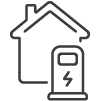
Electric Vehicles & Charging Systems
Protect your EV investment with a properly installed charger.
Buying an electric vehicle (EV) is a decision many of us will face in the coming years. Perhaps you already have or are strongly considering it.
It’s an important and exciting purchase! It’s also an investment worth protecting. Admittedly, the charging system for an EV is not nearly as interesting or exciting as the car itself—but purchasing an unsafe charger or passing on a proper installation can have disastrous consequences for the car, your home, and your family.
Ensuring safe EV charger installation
Hire a Licensed Electrical Contractor
In Ontario, if you’re hiring someone to do electrical work in your home, by law, it must be a Licensed Electrical Contractor (LEC) with an ECRA/ESA licence. LECs are also fully insured and reduce the risks of electrical work in several ways.
Unlicensed or unpermitted work is simply not worth the risk. Electrical fires or other damage to your new EV is too steep a price to pay for convenience.
Find a Licensed Electrical Contractor Near You
Hire someone who can legally install an EV charger in Ontario.
Ensure you have the appropriate electrical panel
Electric vehicles can use a lot of power. It’s important to make sure that your electrical panel can handle the extra load. If your home requires an electrical panel upgrade, you will need to contact your local utility.
A Licensed Electrical Contractor can assist you in assessing and upgrading your panel.
Look for a certification mark
An EV charging system must carry the official mark or label of a recognized certification or evaluation agency. Before an electrical product or piece of electrical equipment is used, sold, displayed, or advertised for sale in Ontario, it needs to be approved by an accredited certification or evaluation agency. This indicates that the product has been independently assessed for safety.

Click here to view a comprehensive chart of the approval marks.
File a Notification of Work (i.e Permit)
The Licensed Electrical Contractor doing the installation must file a notification of work with ESA before starting the installation. Ask for a copy for your records.
A Licensed Electrical Contractor will always complete the filing, and they will also provide you with the ESA Certificate of Acceptance once the work has been completed and accepted as compliant with the Ontario Electrical Safety Code.
A note about EV charger levels
Electric vehicles have different levels and types of charging that use different voltages (Volts) and amperages (Amps) to run. There are three levels of charging for EVs. Level 1 and 2 are used for at-home charging:
- Level 1: This is a charger that uses a standard 120 Volt household outlet. It’s the slowest speed of charging for an EV.
- Level 2: These charging stations have about the same requirements as a large household appliance like a stove or dryer (240 Volts / 30 Amps). Level 2 offers a faster charging time than level 1.
- Level 3: Level 3 charging stations are designed for commercial use and are not suitable for home installation.
Preparing for electric vehicle ownership.
Other considerations & tips
Your charging system is probably the most important change to consider at home. But an EV can change your life and routine in other ways as well. Here are some things worth thinking about.
|
Garage space |
If your charger is going to go in the garage, map out how you prefer to park your car. You will want the EV’s charge port and the charging system close together so that you aren’t running a cord across the garage. If your garage has items or furniture in your ideal spot, plan for where they might go. A Licensed Electrical Contractor can help you determine the best spot in the garage for the charger—based on both convenience and wiring requirements. |
|---|---|
|
Calculate cost-savings |
Your fuel costs will change—for the better—with a new EV or hybrid. Before making the switch, take note of your average weekly or monthly travel distance and fuel costs. Using your EV’s manual or online information, you should be able to estimate the electricity cost for travelling a similar distance. The most common measurement used in this kind of budgeting is kWh/100 km (kilowatt-hours per 100 kilometers). Example: if you travel 200km in a week, and your EV battery is rated at 25 kWh/100 km, you will need to pay for 50 kWh to “fuel” your EV every week. Using off-peak Toronto prices for 2023 (1 kWh = $0.074), that’s only $3.70. The Ontario government announced a new ultra-low overnight electricity plan that will help to lower costs for overnight charging. |
|
Map out charging stations |
It pays to be prepared—getting stranded without a charge is, in some ways, more of a hassle than running out of gas. Sites like chargehub.com or chargefinder.com are useful for researching where (and what kind of) EV stations are located along travel routes. |
|
Incentives & rebates |
Keep an eye out for provincial and federal rebate programs available for your purchase. As of 2023, there is a federal program called iZEV that is worth looking into. Currently, Ontario does not offer any EV incentives. |
Resources
Plug’n Drive
Make an appointment to test drive an EV (they have an incredible line-up of EVs available!) and visit the Electric Vehicle Discovery Centre.
Plug’n Drive is a non-profit organization committed to accelerating the adoption of electric vehicles in order to maximize their environmental and economic benefits. Since 2011, Plug’n Drive has established itself as a Canadian leader in the electric vehicle industry, a trusted and unbiased source of information about electric cars, charging stations and the electricity sector. Visit Plug’n Drive.









